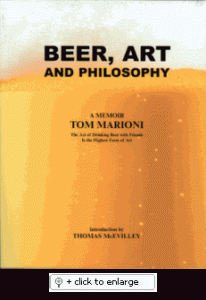Beer, art and philosophy
Beer, Art and Philosophy: A Memoir by Tom Marioni is an awesome book by a living artist. It helped me grasp conceptual art through the use of plain language that pretty much anyone can understand (unlike the magazine ArtForum's 'artspeak' which is almost impossible to understand). I also happen to be a big fan of beer, art AND philosophy. I also highly recommend reading A Brief History of Thought: a philosophical guide to living by the Parisian philosopher and professor Luc Ferry if you want the low down on the origins and journey of (philosophical) thought through time beginning with the Stoics in ancient Greek.
Notes from Beer, Art and Philosophy:
Living on the West Coast exposes you to a subtle Asian influence. After 10 years in California, I became influenced by Zen ideas. My meditative line drawings like Drawing a Line as Far as I Can Reach, and my drumming exercises were my way to connect with Japan. By the late '70's I was anxious to go there. (p. 152)
I believe the best art records society in a poetic way, and in order to do that, I hope the next art will have its own presence. (p. 29)
Artists advance our culture in the world. I didn't take Robert Mapplethrope's "dirty" pictures very seriously, but he launched a homosexual movement into the art mainstream. In the '90's Senator Jesse Helms used Mapplethorpe's pictures to get individual artists' grants eliminated from the NEA program. (p. 105)
Nordland's (San Francisco Museum of Art director, 1966-1971) swan song came in '71 when he organized a show of Paul Jenkins, a decorative abstract painter, the LeRoy Nieman of his day. It was an embarrassment, and I assumed that was why the board fired Nordland. (p. 136)
I don't like to sound pedantic but I believe art is a poetic record of the culture with the power to inspire people to a spiritual awareness. I also think art represents the culture's most excellent examples of visual ideas. You cannot pretend that art and nonart are the same.
Art can become serious again. Even art with wit and art with beauty should have political content, have a subject, make a point, and not be an ornament. Picasso said when he painted his Guernica in 1937 that "painting is not done to decorate apartments; it is an instrument of war...against brutality and darkness."(p. 206)
The comedian George Carlin said, "The job of the comedian is to find where the line is drawn, deliberately cross it, and make the audience glad you took them with you." I would say that's the job of all artists. (p. 209)
